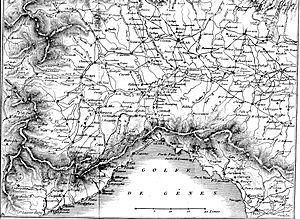Battle of Montebello (1800) facts for kids
Quick facts for kids Battle of Montebello |
|||||||
|---|---|---|---|---|---|---|---|
| Part of the War of the Second Coalition | |||||||
 |
|||||||
|
|||||||
| Belligerents | |||||||
| Commanders and leaders | |||||||
| Strength | |||||||
| 8,000 rising to 14,000 | 18,000 | ||||||
| Casualties and losses | |||||||
| 3,000 | 4,275 and 2 cannons | ||||||
The Battle of Montebello was a big fight that happened on June 9, 1800. It took place near a town called Montebello della Battaglia in Lombardy, Italy. This battle was an important step leading up to the even bigger Battle of Marengo. In this fight, the French army's lead group met and defeated an Austrian force. It was seen as a "glorious victory" for the French.
Contents
Why the Battle Happened
Napoleon and his French army captured Milan on June 2. This left the Austrian army spread out in different places. The main Austrian general, Michael Melas, was in Turin with 18,000 soldiers. Another general, Peter Ott, had 16,000 troops near Genoa. They had just forced the French general André Masséna to surrender Genoa on June 4.
French General Jean Lannes moved his troops south from Milan. He took Pavia and then pushed towards Piacenza. Other French generals, Joachim Murat and Jean Boudet, helped cross the Po River. They managed to get French forces into a key area called the Stradella defile. This spot was important because it was on the main road the Austrians used to communicate.
On June 7, General Ott's Austrian troops were marching north from Genoa. They reached Voghera on June 8. A French patrol spotted them. General Ott decided to have his troops defend the village of Casteggio.
Napoleon thought the Austrian forces were not very strong in this area. He told General Lannes to attack any troops they found. Lannes had about 8,000 men, but he was about to face Ott's much larger force of 18,000.
Who Fought: The Armies
Here are the main commanders and their forces in the battle:
French Forces
- Commander: Jean Lannes
- His main group had about 8,000 soldiers.
- This included divisions led by François Watrin and Joseph Antoine Marie Michel Mainoni.
- They also had cavalry (12th Hussars) and artillery.
- Reinforcements: Later, General Claude Victor-Perrin arrived with about 6,000 more soldiers.
- His division was led by Jacques-Antoine de Chambarlhac de Laubespin.
Austrian Forces
- Commander: Peter Ott
- His army had about 18,000 soldiers.
- They had many infantry battalions and cavalry squadrons.
- They also had 35 cannons, which caused a lot of trouble for the French.
- Key commanders under Ott included Vogelsang, Schellenberg, and O'Reilly.
The Battle Begins
On the morning of June 9, French soldiers from General Watrin's division met an Austrian position. They immediately attacked. An Austrian general named Anton von Zach advised General Ott not to start a big battle. But Ott didn't listen.
Watrin's French troops bravely attacked, but they were outnumbered. They had three main infantry units, two artillery batteries, and one cavalry regiment. The Austrians had 26 infantry battalions and 15 cavalry squadrons. Their 35 cannons were very powerful.
For five hours, the French fought hard. They captured Casteggio twice, but Austrian troops pushed them back each time. Attempts to attack the Austrian side were stopped by Austrian cavalry and artillery. The French 12th Hussars cavalry unit charged many times to protect their infantry.
The Austrians had nine battalions defending a hill and five more waiting in a nearby village called Montebello. The French got some help when three cannons from the Consular Guard arrived.
French Reinforcements Arrive
Around 1:00 pm, General Lannes' troops were almost at their breaking point. That's when General Jacques-Antoine de Chambarlhac de Laubespin's division arrived. These fresh troops were part of General Victor's corps.
General Victor sent his units to attack different parts of the Austrian line. The 43rd Line infantry attacked the Austrian right side. The 24th Light infantry attacked the Austrian left. The 96th Line infantry charged the center.
Even with heavy Austrian cannon fire, the combined French pressure was too much. Ott's tired soldiers were forced to fall back. General Ott ordered a slow retreat. The Austrian battalions led by O'Reilly held Casteggio until the very end. One Austrian regiment, the Reisky Regiment, was almost completely destroyed. Austrian cavalry covered their retreat.
What Happened After: The Result
The Austrians reported heavy losses: 659 killed, 1,445 wounded, and 2,171 captured. They also lost two cannons. The French said they only lost about 600 soldiers, but a more accurate number is probably around 3,000 losses.
Even though the French won, the Battle of Montebello didn't completely ruin the Austrian general Melas's plans. However, the battle really hurt the Austrian soldiers' spirits. General Melas stayed near Alessandria for five days, not making any big moves. He waited for his troops to gather.
The next big fight would be the very important Battle of Marengo on June 14.
General Jean Lannes showed great bravery and skill in this battle. Because of his actions, he was later given the special title of duc de Montebello in 1808.

